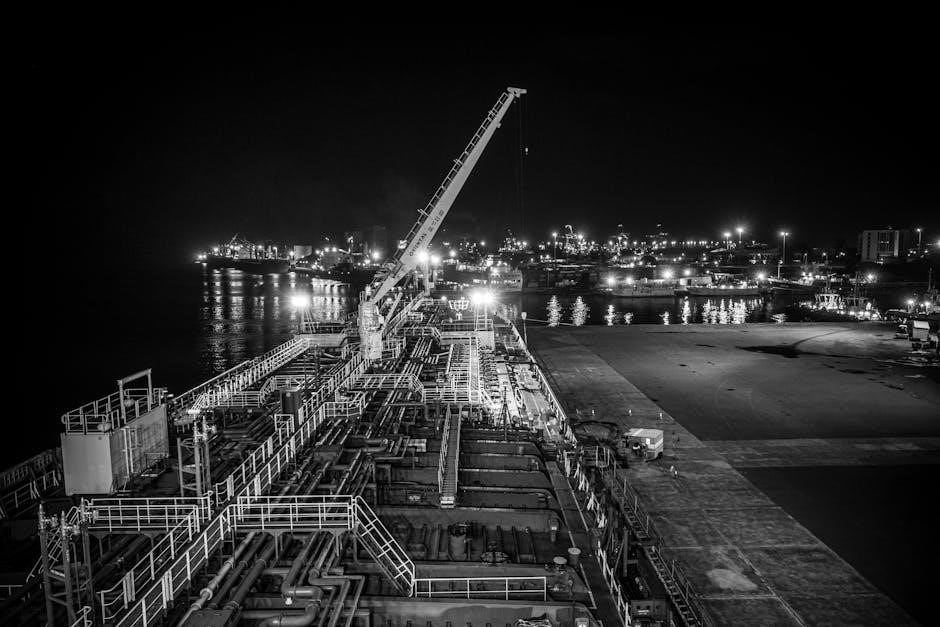Pulse Detonation Engines (PDEs) are advanced propulsion systems utilizing detonation waves for fuel combustion, offering higher efficiency and thrust compared to traditional gas turbine engines.
Definition and Overview
A Pulse Detonation Engine (PDE) is a propulsion system that generates thrust through repetitive detonation waves, combustings fuel and oxidizer mixtures at supersonic speeds. Unlike traditional gas turbine engines, PDEs rely on detonation, a more efficient combustion process than deflagration. The engine operates cyclically, with phases including fuel injection, detonation, exhaust, and refilling. Its high efficiency stems from the direct use of detonation waves, which release energy rapidly, enhancing thermodynamic performance. PDEs are scalable and adaptable, making them suitable for applications ranging from hypersonic aircraft to space propulsion. Despite challenges like pressure fluctuations and noise, ongoing research aims to optimize their design for military, aerospace, and commercial uses, positioning PDEs as a promising alternative to conventional engines.
History and Development
The concept of Pulse Detonation Engines (PDEs) emerged in the early 20th century, with initial studies focusing on detonation-based propulsion. However, significant development began in the 1960s, driven by the need for more efficient engines. Research during the Cold War explored PDEs for military applications, but technical challenges hindered progress. The 1990s saw a resurgence in interest, with advancements in computational modeling and materials science. Organizations like NASA and the U.S. Department of Defense funded projects to address PDE limitations. Recent breakthroughs in detonation control and fuel injection systems have brought PDEs closer to practical implementation. Today, global efforts continue to refine their design, aiming to overcome operational challenges and unlock their full potential for hypersonic and space applications.
Types of Pulse Detonation Engines

Pulse Detonation Engines (PDEs) can be categorized into several types based on their design and operation. The most common type is the conventional PDE, which operates in a pulsed manner, with detonation waves propagating through a straight tube. Another variation is the Rotating Detonation Engine (RDE), which uses a rotating detonation wave to achieve continuous operation. Additionally, Pulse Detonation Rocket Engines (PDREs) are designed for high-speed and space applications, combining the efficiency of PDEs with rocket propulsion principles. Each type differs in design configuration, fuel injection systems, and detonation initiation methods. These variations are tailored to specific applications, ranging from hypersonic aircraft to space exploration. Ongoing research explores hybrid PDE systems, integrating detonation with traditional combustion methods to optimize performance and adaptability across diverse operational requirements.
Working Principle of PDEs
Pulse Detonation Engines (PDEs) operate by detonating a fuel-oxidizer mixture, generating high-pressure waves that expel gases rearward, producing thrust through rapid, cyclic detonation and exhaust processes.
Detonation Process and Combustion
The detonation process in PDEs involves the rapid combustion of a fuel-oxidizer mixture, producing a high-pressure detonation wave. This wave travels at supersonic speeds, ensuring efficient energy release. The combustion chamber is designed to sustain these intense conditions, with fuel injection systems ensuring proper mixing. Unlike traditional deflagration-based engines, PDEs leverage detonation for higher thermodynamic efficiency. The process begins with fuel injection, followed by ignition and rapid propagation of the detonation wave. This cycle repeats, generating consistent thrust. The high-speed combustion and wave propagation enable PDEs to achieve superior performance in various applications, from hypersonic aircraft to space propulsion systems.
Phases of Operation
A pulse detonation engine operates in three distinct phases: combustion, exhaust, and filling. During the combustion phase, a fuel-oxidizer mixture is detonated, generating a high-pressure wave that propagates through the engine. This phase is characterized by rapid energy release and thrust generation. The exhaust phase follows, where the detonation products are expelled from the combustion chamber, creating a low-pressure environment. Finally, the filling phase involves refilling the chamber with a fresh fuel-oxidizer mixture, preparing it for the next detonation cycle. These phases repeat rapidly, ensuring continuous operation. The cyclic nature of PDEs allows for efficient thrust generation, making them suitable for high-speed applications. Each phase is critical to the engine’s performance, requiring precise timing and control to maintain optimal functionality.
Thrust Generation Mechanism
The thrust generation in pulse detonation engines (PDEs) is primarily driven by the detonation wave’s rapid pressure increase and mass expulsion. As the fuel-oxidizer mixture detonates, it produces a high-pressure wave that travels through the combustion chamber. This wave generates a forward force, contributing to thrust. The exhaust of detonation products at high velocity further enhances thrust production. Unlike traditional engines that rely on continuous combustion, PDEs harness the intermittent detonation pulses to create a repetitive thrust-generating cycle. The efficiency of this mechanism is maximized by the detonation’s high-speed propagation and the resulting mass flow acceleration. This unique approach allows PDEs to achieve higher specific impulse and thrust-to-weight ratios compared to conventional propulsion systems, making them particularly advantageous for hypersonic and high-performance applications.

Design and Components
Pulse Detonation Engines (PDEs) feature a streamlined design with key components like the combustion chamber, fuel injection system, and exhaust nozzle, optimized for high thrust and efficiency.
Combustion Chamber Design
The combustion chamber in a Pulse Detonation Engine (PDE) is specifically designed to withstand the high-pressure detonation waves generated during the combustion process. It is typically constructed from robust materials to endure the repetitive stress caused by these intense waves. The chamber’s geometry is optimized to facilitate efficient mixing of fuel and oxidizer, ensuring a consistent and powerful detonation. Additionally, the combustion chamber often incorporates features such as cooling systems to manage the extreme temperatures produced during detonation. This design ensures the engine’s durability and performance over multiple cycles of operation. The precise engineering of the combustion chamber is critical to the overall efficiency and thrust generation of the PDE.
Fuel Injection and Mixing Systems
The fuel injection and mixing systems in Pulse Detonation Engines (PDEs) are critical for achieving efficient detonation. These systems ensure the proper mixing of fuel and oxidizer before ignition, which is essential for generating consistent detonation waves. The design typically involves precise control over the injection timing, flow rates, and spatial distribution of the fuel-air mixture. Advanced injectors are often used to create a homogeneous mixture, which enhances combustion efficiency. The mixing process must occur rapidly to synchronize with the detonation cycle, making it a challenging aspect of PDE design. Researchers have explored various configurations, including multi-point injection and swirling flows, to improve mixing quality. Efficient fuel injection and mixing systems are vital for maximizing the engine’s performance and reliability while minimizing operational challenges.
Exhaust System and Nozzle
The exhaust system and nozzle in Pulse Detonation Engines (PDEs) play a crucial role in optimizing thrust generation and overall engine performance. The exhaust system must efficiently expel the high-velocity gases produced by detonation while minimizing pressure losses. Nozzles are designed to accelerate the exhaust gases to supersonic speeds, enhancing thrust output. PDE nozzles often incorporate unique geometries to handle the cyclic nature of detonation and ensure proper gas expansion. The system must also manage the high thermal loads generated during the detonation process. Research has focused on developing lightweight and durable materials for these components, as well as improving their aerodynamic efficiency. An optimized exhaust system and nozzle are essential for maximizing the engine’s specific impulse and operational efficiency, making them key areas of ongoing innovation in PDE technology.

Applications of Pulse Detonation Engines
Pulse Detonation Engines (PDEs) are primarily applied in military, space exploration, hypersonic aircraft, and UAVs, offering high efficiency, thrust, and performance for advanced propulsion systems in these fields.
Military and Defense Applications
Pulse Detonation Engines (PDEs) are increasingly being explored for military and defense applications due to their potential to enhance propulsion systems in missiles, unmanned aerial vehicles (UAVs), and hypersonic weapons. Their high fuel efficiency and thrust generation capabilities make them ideal for applications requiring rapid acceleration and long-range capabilities. PDEs can power advanced missile systems, enabling faster response times and increased lethality. Additionally, their compact design and lightweight construction make them suitable for integration into next-generation unmanned combat air vehicles (UCAVs). The ability of PDEs to operate efficiently at hypersonic speeds also aligns with the development of hypersonic weapons, a key area of focus for modern military forces. Current research and testing by defense organizations, such as DRDO and Rostec, highlight the potential of PDEs to revolutionize military propulsion systems, offering a strategic advantage in future conflicts.

Space Exploration and Propulsion
Pulse Detonation Engines (PDEs) are emerging as a promising technology for space exploration due to their potential to enhance propulsion efficiency in orbital and interplanetary missions. The high-specific-impulse characteristics of PDEs make them suitable for propelling spacecraft, particularly in scenarios requiring rapid acceleration and fuel efficiency. Researchers are exploring PDEs for use in rocket motors that could power orbital spaceplanes and hypersonic aircraft capable of reaching the edge of space. The compact design and lightweight construction of PDEs also make them ideal for integration into next-generation spacecraft, where mass reduction is critical. Additionally, their ability to operate efficiently across a wide range of altitudes and speeds aligns with the demands of space exploration missions. Current developments by organizations such as United Engine and ASI are focused on refining PDE technology for space applications, aiming to overcome traditional rocket engine limitations and pave the way for more efficient and cost-effective space travel.
Hypersonic Aircraft and UAVs
Pulse Detonation Engines (PDEs) are being actively explored for their potential to power hypersonic aircraft and Unmanned Aerial Vehicles (UAVs). Hypersonic flight demands propulsion systems capable of sustaining speeds above Mach 5, where traditional jet engines lose efficiency. PDEs offer a solution by leveraging detonation waves to combust fuel, providing higher thrust and specific impulse compared to conventional engines. This makes them particularly suitable for hypersonic applications, where rapid acceleration and sustained high speeds are critical. Current research highlights the potential of PDEs for supersonic unmanned combat air vehicles, which require both speed and maneuverability. Additionally, the compact and lightweight design of PDEs aligns well with the needs of UAVs, enabling longer mission durations and greater operational flexibility. As hypersonic technology advances, PDEs are poised to play a pivotal role in the development of next-generation aircraft, offering enhanced performance and capabilities for both military and civilian applications.

Advantages and Challenges
Efficiency and Performance Benefits
PDEs offer higher fuel efficiency and a more efficient thermodynamic cycle compared to traditional gas turbines, making them promising for hypersonic and space applications.
Technical and Operational Challenges
The repetitive detonation process poses structural challenges, while noise levels and detonation control in insensitive fuels remain significant technical hurdles requiring advanced engineering solutions.
Pulse Detonation Engines (PDEs) offer significant efficiency and performance advantages over traditional propulsion systems. Their ability to harness detonation waves enables a more efficient thermodynamic cycle, achieving higher fuel efficiency compared to conventional gas turbine engines. This makes PDEs particularly promising for hypersonic aircraft, unmanned aerial vehicles (UAVs), and space exploration applications. The repetitive detonation process allows for a compact design, reducing weight and enhancing thrust-to-weight ratios. Additionally, PDEs can operate effectively across a wide range of speeds, from subsonic to hypersonic, making them versatile for various missions. Their simplified combustion process also reduces moving parts, potentially lowering maintenance costs and increasing reliability. Overall, the unique combustion mechanism of PDEs provides a leap forward in propulsion technology, offering improved performance and operational flexibility for future aerospace systems.
Pulse Detonation Engines (PDEs) face several technical and operational challenges that hinder their widespread adoption. One major issue is the high-pressure fluctuations generated by detonation waves, which can cause structural stress and require robust materials for the combustion chamber and exhaust system. Additionally, the repetitive detonation process creates significant thermal loads, necessitating advanced cooling systems to prevent overheating. Noise levels are also a concern, as the explosive nature of detonation produces loud exhaust signals. Furthermore, achieving consistent and reliable fuel-air mixing and ignition remains a challenge, particularly with insensitive liquid fuels. The cyclic operation of PDEs requires precise control systems to synchronize fuel injection, detonation initiation, and exhaust phases, adding complexity to engine design and operation. These challenges underscore the need for further research and development to address material limitations, thermal management, and operational stability.

Research and Development
Research on PDEs focuses on improving efficiency, reducing noise, and enhancing reliability. Ongoing testing by companies like Rostec and United Engine highlights potential for hypersonic and space applications.
Current Research Trends
Current research focuses on optimizing PDE performance, including detonation control and fuel efficiency. Studies explore advanced materials and designs to handle high-pressure waves, ensuring durability and reliability. Efforts also address noise reduction and scalability for various applications, from hypersonic aircraft to space propulsion. Experimental testing, such as by Rostec and United Engine, validates concepts and identifies challenges. Simulations and modeling tools are increasingly used to predict engine behavior and improve designs. Collaboration between academia and industry accelerates progress, aiming to overcome technical barriers and unlock PDE’s full potential for next-generation propulsion systems.
Future Directions and Innovations
Future innovations in PDE technology aim to enhance efficiency, reduce noise, and expand application domains. Researchers are exploring alternative fuels, hybrid PDE-scramjet systems, and advanced detonation control methods. AI-driven design optimization is emerging as a key tool to improve combustion chamber geometries and fuel injection systems. Lightweight, high-temperature materials are being developed to withstand extreme operational conditions. Additionally, integration of PDEs with hypersonic vehicles and spaceplanes is a priority, with concepts like rotating detonation engines showing promise. These advancements could revolutionize propulsion systems, offering unparalleled performance for military, aerospace, and commercial uses. Ongoing collaborations between academia and industry are expected to accelerate breakthroughs, making PDEs a cornerstone of future propulsion technology.
Case Studies and Examples
Several notable case studies highlight the development and testing of PDEs. For instance, the Russian company United Engine conducted initial tests on a pulse-detonation rocket motor, showcasing its potential for hypersonic aircraft and spaceplanes. Additionally, a test system utilizing a PCI-6115 Data Acquisition Card demonstrated the feasibility of PDE operation in controlled environments. UCLA’s Combustion Research Laboratory has also contributed significantly through simulations of PDE wave dynamics. These examples illustrate the practical applications and ongoing research efforts in refining PDE technology. Such studies are crucial for overcoming technical challenges and advancing the field, providing valuable insights into the design and performance of PDE systems for future applications.

Pulse Detonation Engines offer promising advancements in propulsion systems, with higher fuel efficiency and potential applications in hypersonic aircraft and space exploration. Further reading is available through referenced studies.

Pulse Detonation Engines (PDEs) represent a groundbreaking propulsion technology with significant potential in hypersonic and space applications. Their ability to achieve higher fuel efficiency and thrust compared to traditional gas turbine engines makes them a focal point for future advancements. Recent research highlights the progress in overcoming technical challenges, such as detonation control and materials durability. As hypersonic aircraft and UAVs gain traction, PDEs are poised to play a pivotal role in next-generation propulsion systems. Ongoing studies and innovations, particularly in detonation wave management and combustion chamber design, are expected to further enhance performance. The future outlook for PDEs is promising, with potential applications in both military and civilian sectors, driving continued investment and development in this field.
References and Further Reading

For deeper insights into Pulse Detonation Engines, key references include works by YV Tunik, exploring detonation control and propulsion systems, and research by ЮИ Цыбизов on multichannel PDE designs. UCLA’s Combustion Research Laboratory provides valuable simulations and configurations of PDE systems. Additionally, studies by RK Seleznev and КН Волков delve into scramjet integration and thermodynamic cycle improvements. For further reading, consult “Pulse Detonation Engine: A Review” by ASI, “Transient Combustion and Detonation Control”, and “Pulse Detonation Rocket Engines” by AIAA. These resources offer comprehensive analysis and advancements in PDE technology, ideal for researchers and engineers seeking detailed understanding and application.

